BMP3005 - Financial Management Report: Applied Business Finance Report
VerifiedAdded on 2023/06/18
|10
|2283
|290
Report
AI Summary
This report provides a comprehensive analysis of financial management concepts and their practical application in a business context. It defines financial management and discusses its importance in improving decision-making, promoting company growth, and minimizing financial risk. The report details the main financial statements, including the income statement, balance sheet, and cash flow statement, and explains the use of ratios in financial management for performance evaluation and risk assessment. A business review template is used to prepare financial statements, and ratio analysis is conducted to assess the profitability, liquidity, and efficiency of a sample organization. Finally, the report suggests strategies for business improvement, such as focusing on innovation, technology development, and expense minimization. This document is available on Desklib, where students can find a wide range of study resources, including past papers and solved assignments.
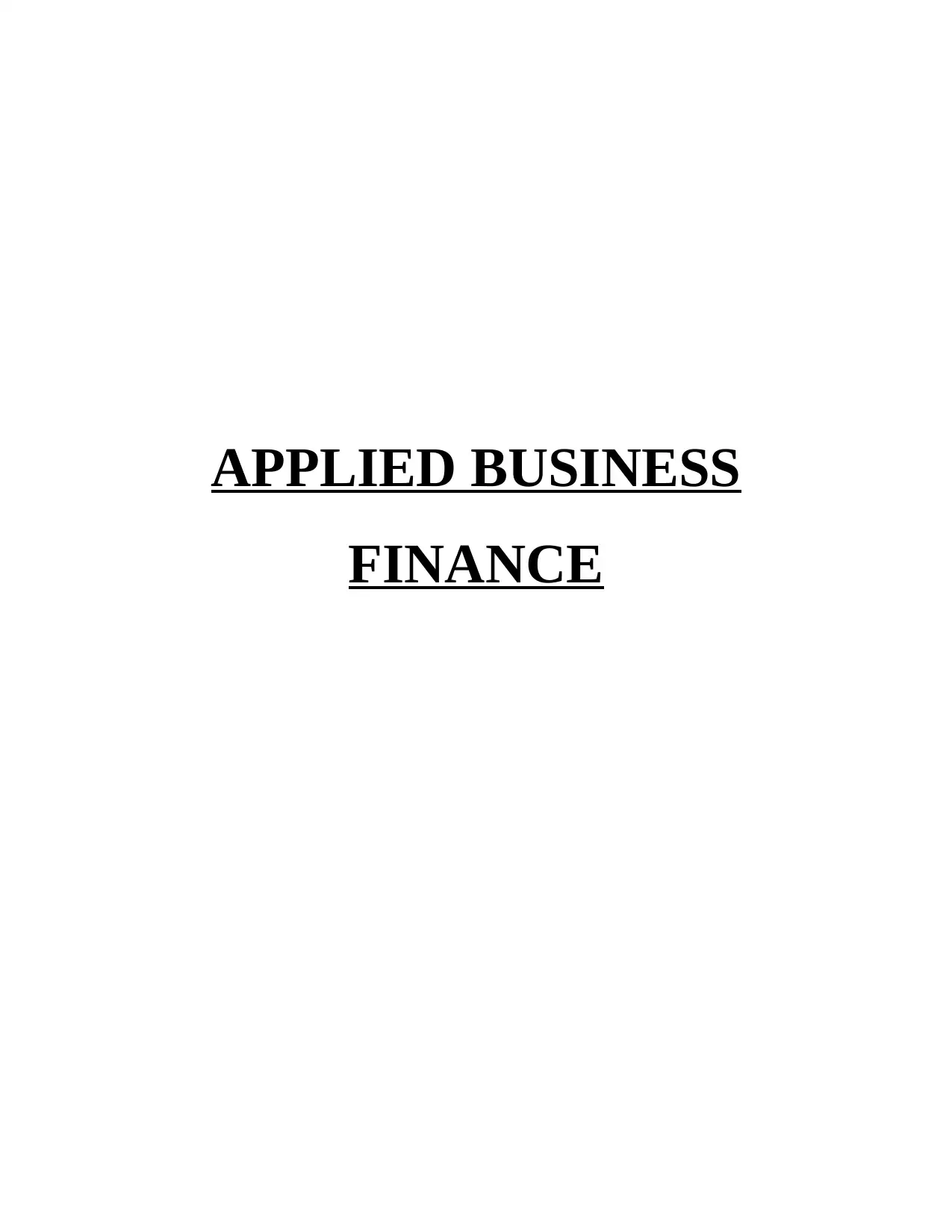
APPLIED BUSINESS
FINANCE
FINANCE
Paraphrase This Document
Need a fresh take? Get an instant paraphrase of this document with our AI Paraphraser
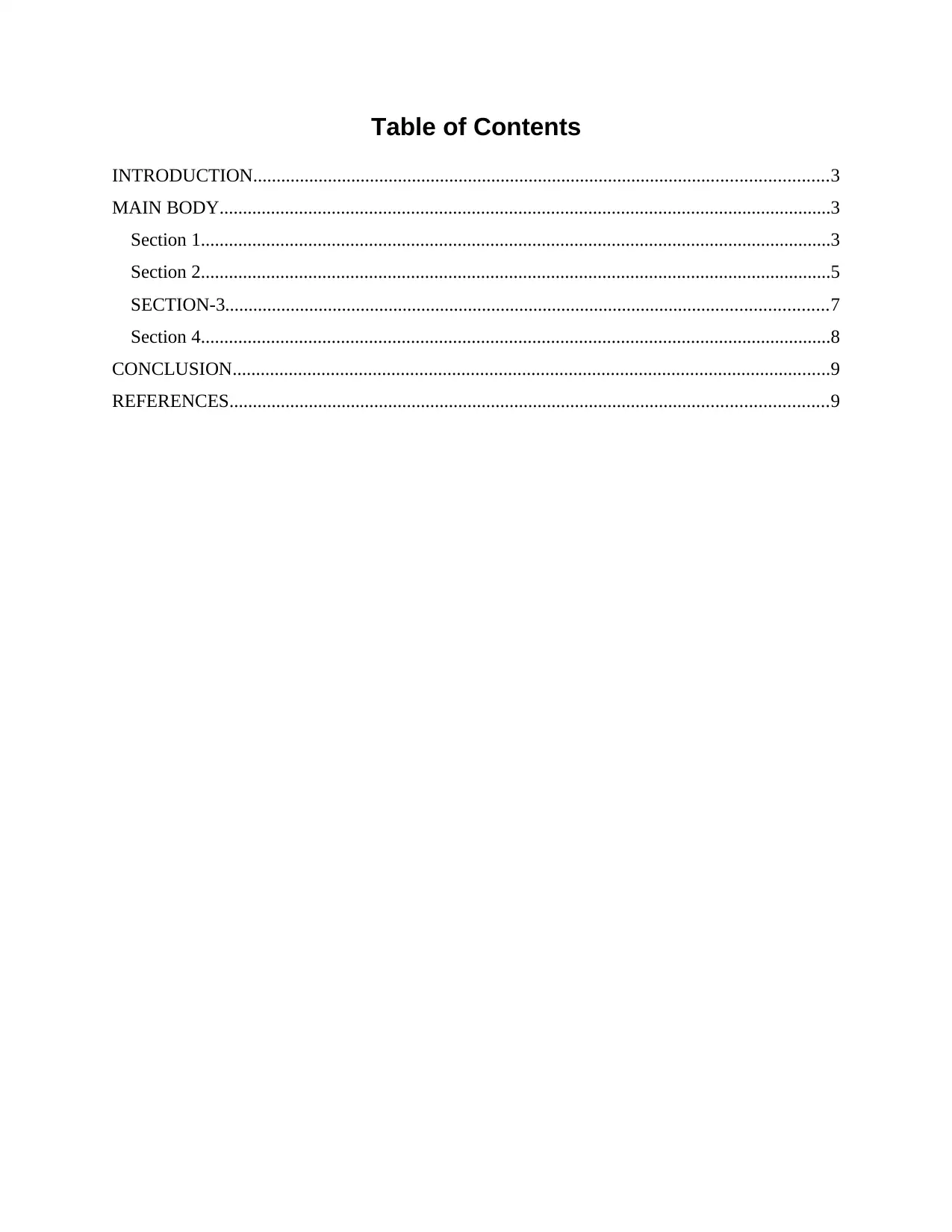
Table of Contents
INTRODUCTION...........................................................................................................................3
MAIN BODY...................................................................................................................................3
Section 1.......................................................................................................................................3
Section 2.......................................................................................................................................5
SECTION-3.................................................................................................................................7
Section 4.......................................................................................................................................8
CONCLUSION................................................................................................................................9
REFERENCES................................................................................................................................9
INTRODUCTION...........................................................................................................................3
MAIN BODY...................................................................................................................................3
Section 1.......................................................................................................................................3
Section 2.......................................................................................................................................5
SECTION-3.................................................................................................................................7
Section 4.......................................................................................................................................8
CONCLUSION................................................................................................................................9
REFERENCES................................................................................................................................9
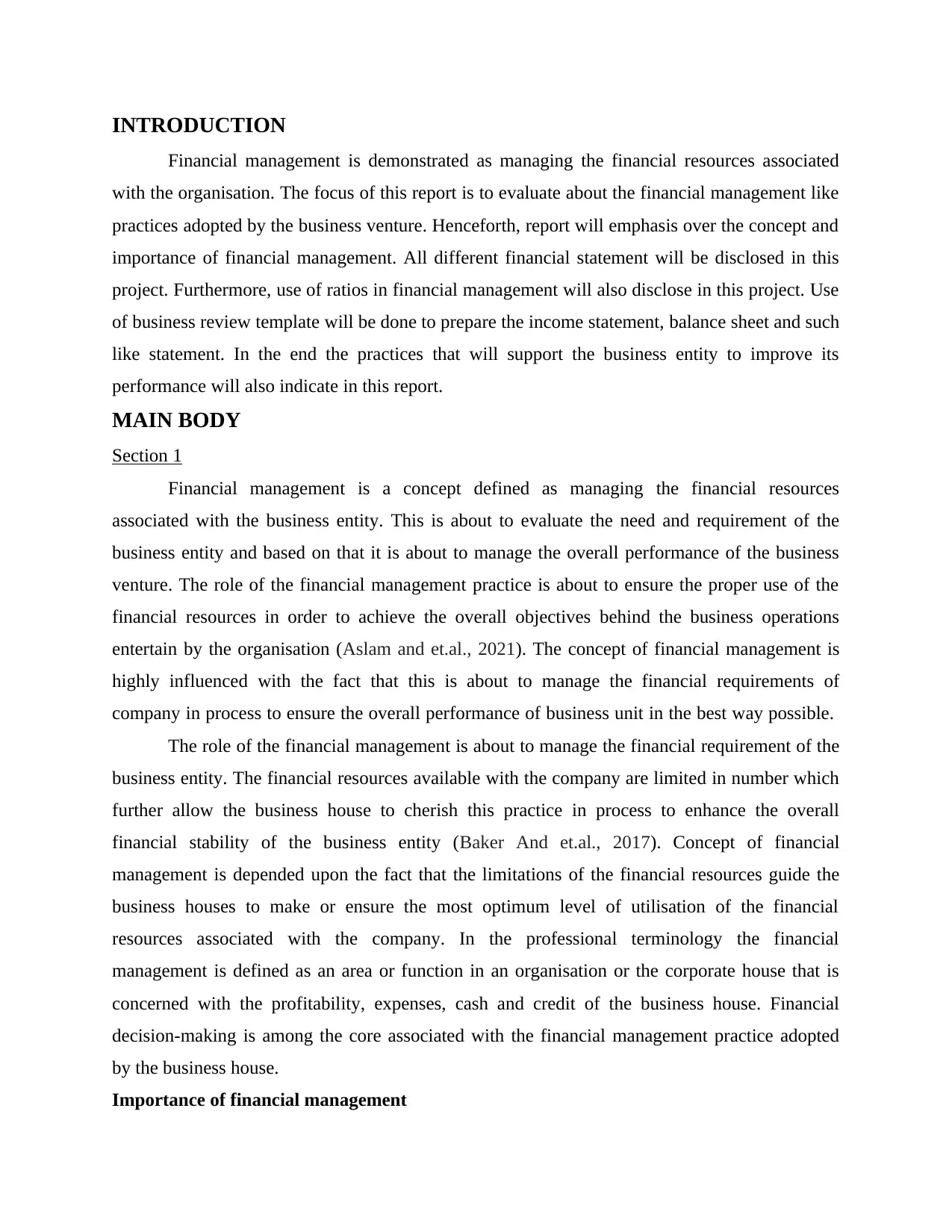
INTRODUCTION
Financial management is demonstrated as managing the financial resources associated
with the organisation. The focus of this report is to evaluate about the financial management like
practices adopted by the business venture. Henceforth, report will emphasis over the concept and
importance of financial management. All different financial statement will be disclosed in this
project. Furthermore, use of ratios in financial management will also disclose in this project. Use
of business review template will be done to prepare the income statement, balance sheet and such
like statement. In the end the practices that will support the business entity to improve its
performance will also indicate in this report.
MAIN BODY
Section 1
Financial management is a concept defined as managing the financial resources
associated with the business entity. This is about to evaluate the need and requirement of the
business entity and based on that it is about to manage the overall performance of the business
venture. The role of the financial management practice is about to ensure the proper use of the
financial resources in order to achieve the overall objectives behind the business operations
entertain by the organisation (Aslam and et.al., 2021). The concept of financial management is
highly influenced with the fact that this is about to manage the financial requirements of
company in process to ensure the overall performance of business unit in the best way possible.
The role of the financial management is about to manage the financial requirement of the
business entity. The financial resources available with the company are limited in number which
further allow the business house to cherish this practice in process to enhance the overall
financial stability of the business entity (Baker And et.al., 2017). Concept of financial
management is depended upon the fact that the limitations of the financial resources guide the
business houses to make or ensure the most optimum level of utilisation of the financial
resources associated with the company. In the professional terminology the financial
management is defined as an area or function in an organisation or the corporate house that is
concerned with the profitability, expenses, cash and credit of the business house. Financial
decision-making is among the core associated with the financial management practice adopted
by the business house.
Importance of financial management
Financial management is demonstrated as managing the financial resources associated
with the organisation. The focus of this report is to evaluate about the financial management like
practices adopted by the business venture. Henceforth, report will emphasis over the concept and
importance of financial management. All different financial statement will be disclosed in this
project. Furthermore, use of ratios in financial management will also disclose in this project. Use
of business review template will be done to prepare the income statement, balance sheet and such
like statement. In the end the practices that will support the business entity to improve its
performance will also indicate in this report.
MAIN BODY
Section 1
Financial management is a concept defined as managing the financial resources
associated with the business entity. This is about to evaluate the need and requirement of the
business entity and based on that it is about to manage the overall performance of the business
venture. The role of the financial management practice is about to ensure the proper use of the
financial resources in order to achieve the overall objectives behind the business operations
entertain by the organisation (Aslam and et.al., 2021). The concept of financial management is
highly influenced with the fact that this is about to manage the financial requirements of
company in process to ensure the overall performance of business unit in the best way possible.
The role of the financial management is about to manage the financial requirement of the
business entity. The financial resources available with the company are limited in number which
further allow the business house to cherish this practice in process to enhance the overall
financial stability of the business entity (Baker And et.al., 2017). Concept of financial
management is depended upon the fact that the limitations of the financial resources guide the
business houses to make or ensure the most optimum level of utilisation of the financial
resources associated with the company. In the professional terminology the financial
management is defined as an area or function in an organisation or the corporate house that is
concerned with the profitability, expenses, cash and credit of the business house. Financial
decision-making is among the core associated with the financial management practice adopted
by the business house.
Importance of financial management
⊘ This is a preview!⊘
Do you want full access?
Subscribe today to unlock all pages.

Trusted by 1+ million students worldwide
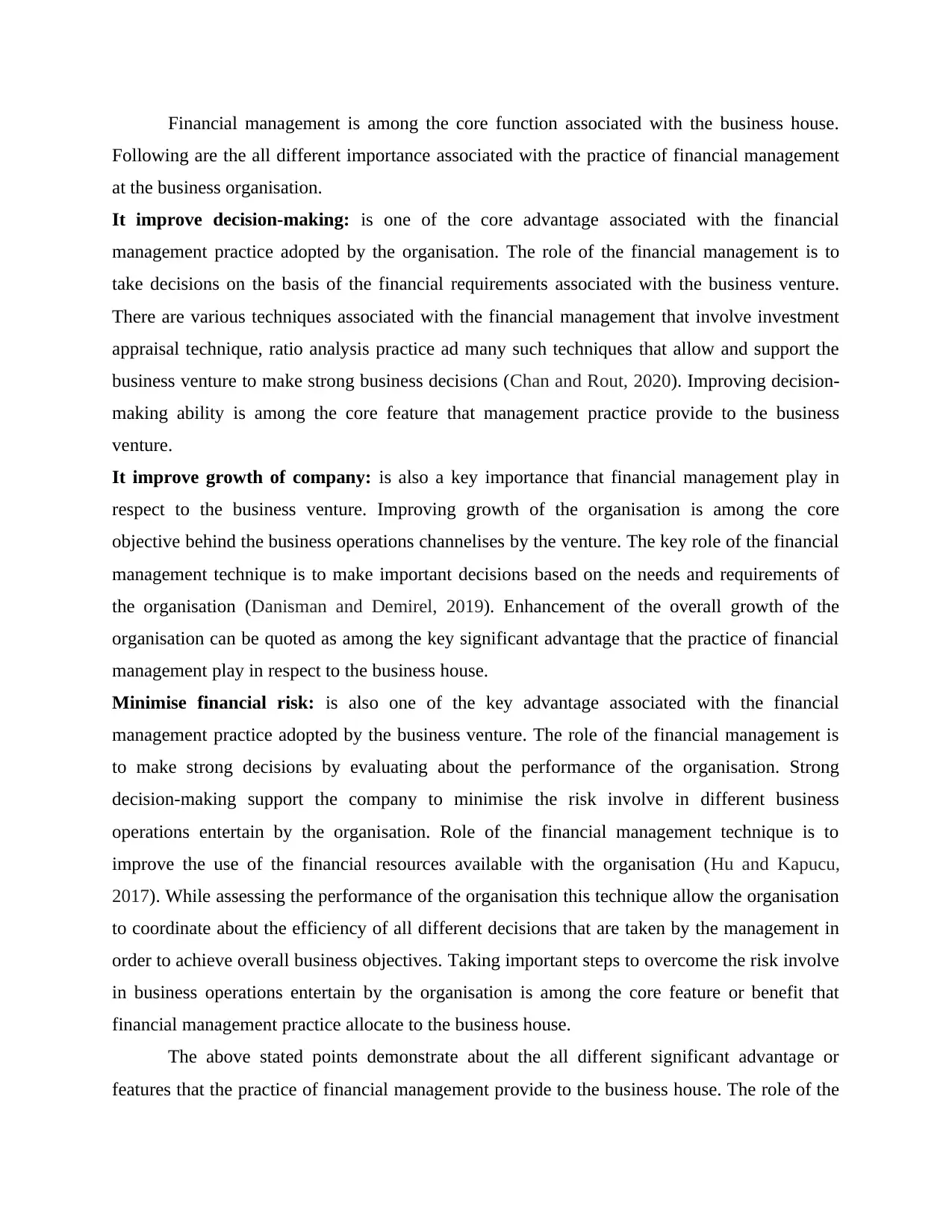
Financial management is among the core function associated with the business house.
Following are the all different importance associated with the practice of financial management
at the business organisation.
It improve decision-making: is one of the core advantage associated with the financial
management practice adopted by the organisation. The role of the financial management is to
take decisions on the basis of the financial requirements associated with the business venture.
There are various techniques associated with the financial management that involve investment
appraisal technique, ratio analysis practice ad many such techniques that allow and support the
business venture to make strong business decisions (Chan and Rout, 2020). Improving decision-
making ability is among the core feature that management practice provide to the business
venture.
It improve growth of company: is also a key importance that financial management play in
respect to the business venture. Improving growth of the organisation is among the core
objective behind the business operations channelises by the venture. The key role of the financial
management technique is to make important decisions based on the needs and requirements of
the organisation (Danisman and Demirel, 2019). Enhancement of the overall growth of the
organisation can be quoted as among the key significant advantage that the practice of financial
management play in respect to the business house.
Minimise financial risk: is also one of the key advantage associated with the financial
management practice adopted by the business venture. The role of the financial management is
to make strong decisions by evaluating about the performance of the organisation. Strong
decision-making support the company to minimise the risk involve in different business
operations entertain by the organisation. Role of the financial management technique is to
improve the use of the financial resources available with the organisation (Hu and Kapucu,
2017). While assessing the performance of the organisation this technique allow the organisation
to coordinate about the efficiency of all different decisions that are taken by the management in
order to achieve overall business objectives. Taking important steps to overcome the risk involve
in business operations entertain by the organisation is among the core feature or benefit that
financial management practice allocate to the business house.
The above stated points demonstrate about the all different significant advantage or
features that the practice of financial management provide to the business house. The role of the
Following are the all different importance associated with the practice of financial management
at the business organisation.
It improve decision-making: is one of the core advantage associated with the financial
management practice adopted by the organisation. The role of the financial management is to
take decisions on the basis of the financial requirements associated with the business venture.
There are various techniques associated with the financial management that involve investment
appraisal technique, ratio analysis practice ad many such techniques that allow and support the
business venture to make strong business decisions (Chan and Rout, 2020). Improving decision-
making ability is among the core feature that management practice provide to the business
venture.
It improve growth of company: is also a key importance that financial management play in
respect to the business venture. Improving growth of the organisation is among the core
objective behind the business operations channelises by the venture. The key role of the financial
management technique is to make important decisions based on the needs and requirements of
the organisation (Danisman and Demirel, 2019). Enhancement of the overall growth of the
organisation can be quoted as among the key significant advantage that the practice of financial
management play in respect to the business house.
Minimise financial risk: is also one of the key advantage associated with the financial
management practice adopted by the business venture. The role of the financial management is
to make strong decisions by evaluating about the performance of the organisation. Strong
decision-making support the company to minimise the risk involve in different business
operations entertain by the organisation. Role of the financial management technique is to
improve the use of the financial resources available with the organisation (Hu and Kapucu,
2017). While assessing the performance of the organisation this technique allow the organisation
to coordinate about the efficiency of all different decisions that are taken by the management in
order to achieve overall business objectives. Taking important steps to overcome the risk involve
in business operations entertain by the organisation is among the core feature or benefit that
financial management practice allocate to the business house.
The above stated points demonstrate about the all different significant advantage or
features that the practice of financial management provide to the business house. The role of the
Paraphrase This Document
Need a fresh take? Get an instant paraphrase of this document with our AI Paraphraser
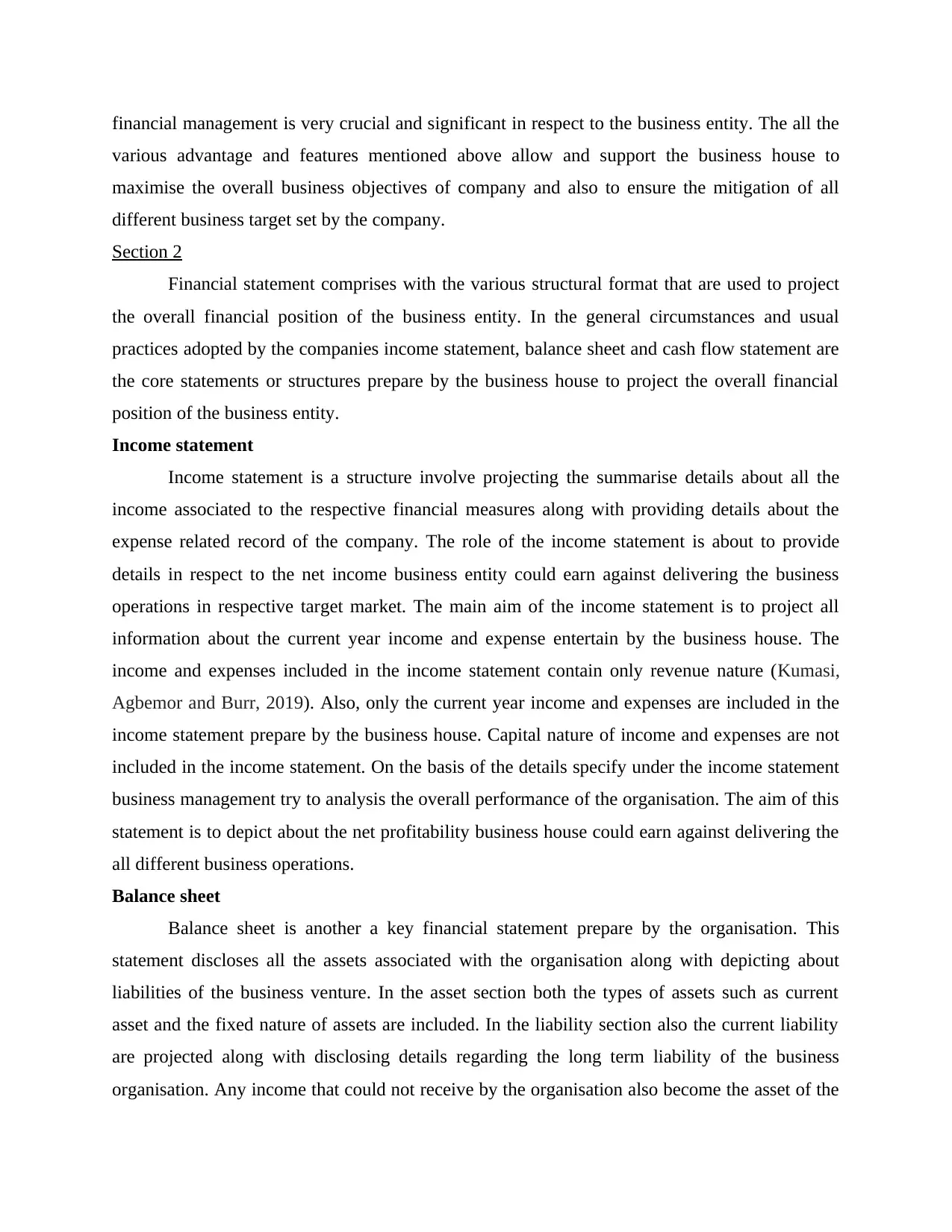
financial management is very crucial and significant in respect to the business entity. The all the
various advantage and features mentioned above allow and support the business house to
maximise the overall business objectives of company and also to ensure the mitigation of all
different business target set by the company.
Section 2
Financial statement comprises with the various structural format that are used to project
the overall financial position of the business entity. In the general circumstances and usual
practices adopted by the companies income statement, balance sheet and cash flow statement are
the core statements or structures prepare by the business house to project the overall financial
position of the business entity.
Income statement
Income statement is a structure involve projecting the summarise details about all the
income associated to the respective financial measures along with providing details about the
expense related record of the company. The role of the income statement is about to provide
details in respect to the net income business entity could earn against delivering the business
operations in respective target market. The main aim of the income statement is to project all
information about the current year income and expense entertain by the business house. The
income and expenses included in the income statement contain only revenue nature (Kumasi,
Agbemor and Burr, 2019). Also, only the current year income and expenses are included in the
income statement prepare by the business house. Capital nature of income and expenses are not
included in the income statement. On the basis of the details specify under the income statement
business management try to analysis the overall performance of the organisation. The aim of this
statement is to depict about the net profitability business house could earn against delivering the
all different business operations.
Balance sheet
Balance sheet is another a key financial statement prepare by the organisation. This
statement discloses all the assets associated with the organisation along with depicting about
liabilities of the business venture. In the asset section both the types of assets such as current
asset and the fixed nature of assets are included. In the liability section also the current liability
are projected along with disclosing details regarding the long term liability of the business
organisation. Any income that could not receive by the organisation also become the asset of the
various advantage and features mentioned above allow and support the business house to
maximise the overall business objectives of company and also to ensure the mitigation of all
different business target set by the company.
Section 2
Financial statement comprises with the various structural format that are used to project
the overall financial position of the business entity. In the general circumstances and usual
practices adopted by the companies income statement, balance sheet and cash flow statement are
the core statements or structures prepare by the business house to project the overall financial
position of the business entity.
Income statement
Income statement is a structure involve projecting the summarise details about all the
income associated to the respective financial measures along with providing details about the
expense related record of the company. The role of the income statement is about to provide
details in respect to the net income business entity could earn against delivering the business
operations in respective target market. The main aim of the income statement is to project all
information about the current year income and expense entertain by the business house. The
income and expenses included in the income statement contain only revenue nature (Kumasi,
Agbemor and Burr, 2019). Also, only the current year income and expenses are included in the
income statement prepare by the business house. Capital nature of income and expenses are not
included in the income statement. On the basis of the details specify under the income statement
business management try to analysis the overall performance of the organisation. The aim of this
statement is to depict about the net profitability business house could earn against delivering the
all different business operations.
Balance sheet
Balance sheet is another a key financial statement prepare by the organisation. This
statement discloses all the assets associated with the organisation along with depicting about
liabilities of the business venture. In the asset section both the types of assets such as current
asset and the fixed nature of assets are included. In the liability section also the current liability
are projected along with disclosing details regarding the long term liability of the business
organisation. Any income that could not receive by the organisation also become the asset of the
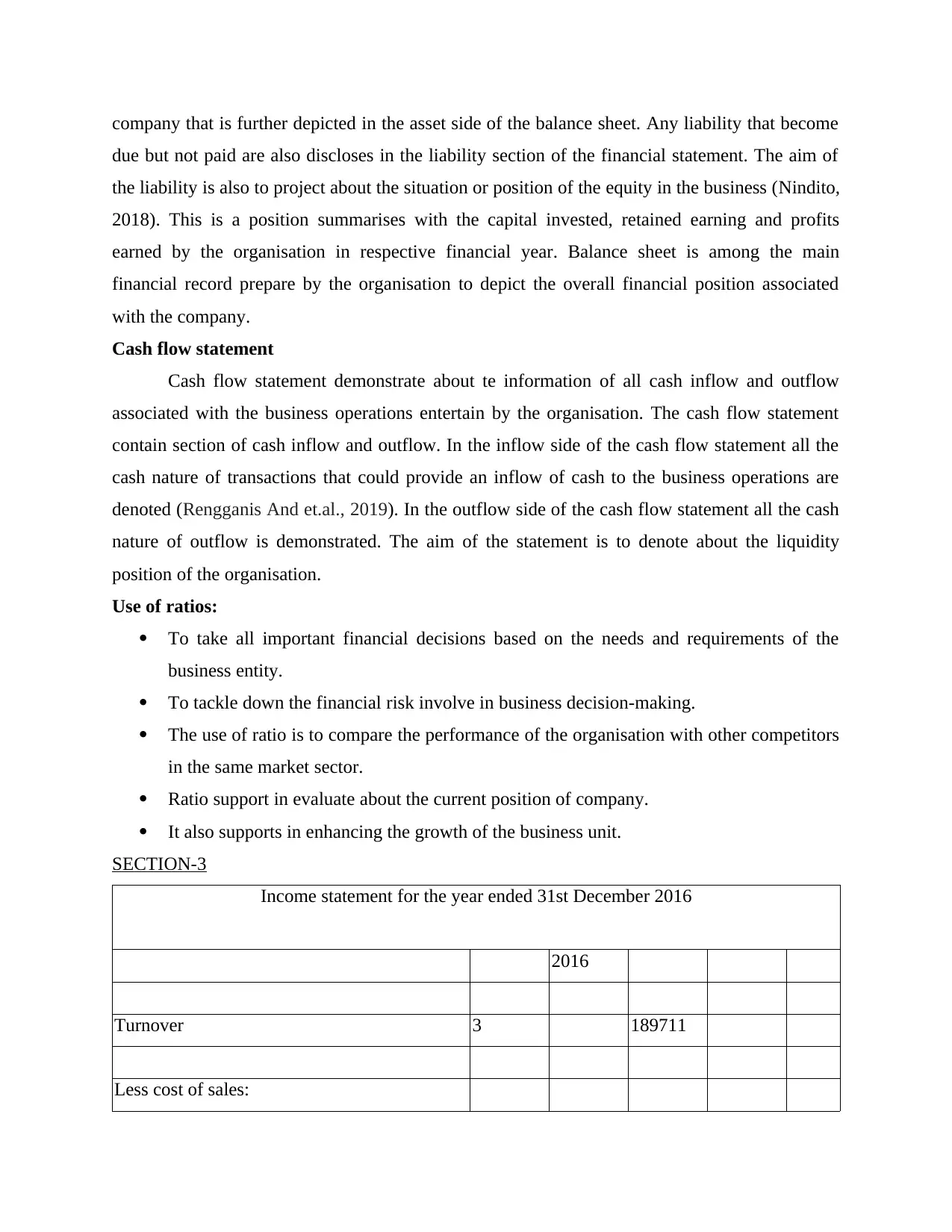
company that is further depicted in the asset side of the balance sheet. Any liability that become
due but not paid are also discloses in the liability section of the financial statement. The aim of
the liability is also to project about the situation or position of the equity in the business (Nindito,
2018). This is a position summarises with the capital invested, retained earning and profits
earned by the organisation in respective financial year. Balance sheet is among the main
financial record prepare by the organisation to depict the overall financial position associated
with the company.
Cash flow statement
Cash flow statement demonstrate about te information of all cash inflow and outflow
associated with the business operations entertain by the organisation. The cash flow statement
contain section of cash inflow and outflow. In the inflow side of the cash flow statement all the
cash nature of transactions that could provide an inflow of cash to the business operations are
denoted (Rengganis And et.al., 2019). In the outflow side of the cash flow statement all the cash
nature of outflow is demonstrated. The aim of the statement is to denote about the liquidity
position of the organisation.
Use of ratios:
To take all important financial decisions based on the needs and requirements of the
business entity.
To tackle down the financial risk involve in business decision-making.
The use of ratio is to compare the performance of the organisation with other competitors
in the same market sector.
Ratio support in evaluate about the current position of company.
It also supports in enhancing the growth of the business unit.
SECTION-3
Income statement for the year ended 31st December 2016
2016
Turnover 3 189711
Less cost of sales:
due but not paid are also discloses in the liability section of the financial statement. The aim of
the liability is also to project about the situation or position of the equity in the business (Nindito,
2018). This is a position summarises with the capital invested, retained earning and profits
earned by the organisation in respective financial year. Balance sheet is among the main
financial record prepare by the organisation to depict the overall financial position associated
with the company.
Cash flow statement
Cash flow statement demonstrate about te information of all cash inflow and outflow
associated with the business operations entertain by the organisation. The cash flow statement
contain section of cash inflow and outflow. In the inflow side of the cash flow statement all the
cash nature of transactions that could provide an inflow of cash to the business operations are
denoted (Rengganis And et.al., 2019). In the outflow side of the cash flow statement all the cash
nature of outflow is demonstrated. The aim of the statement is to denote about the liquidity
position of the organisation.
Use of ratios:
To take all important financial decisions based on the needs and requirements of the
business entity.
To tackle down the financial risk involve in business decision-making.
The use of ratio is to compare the performance of the organisation with other competitors
in the same market sector.
Ratio support in evaluate about the current position of company.
It also supports in enhancing the growth of the business unit.
SECTION-3
Income statement for the year ended 31st December 2016
2016
Turnover 3 189711
Less cost of sales:
⊘ This is a preview!⊘
Do you want full access?
Subscribe today to unlock all pages.

Trusted by 1+ million students worldwide
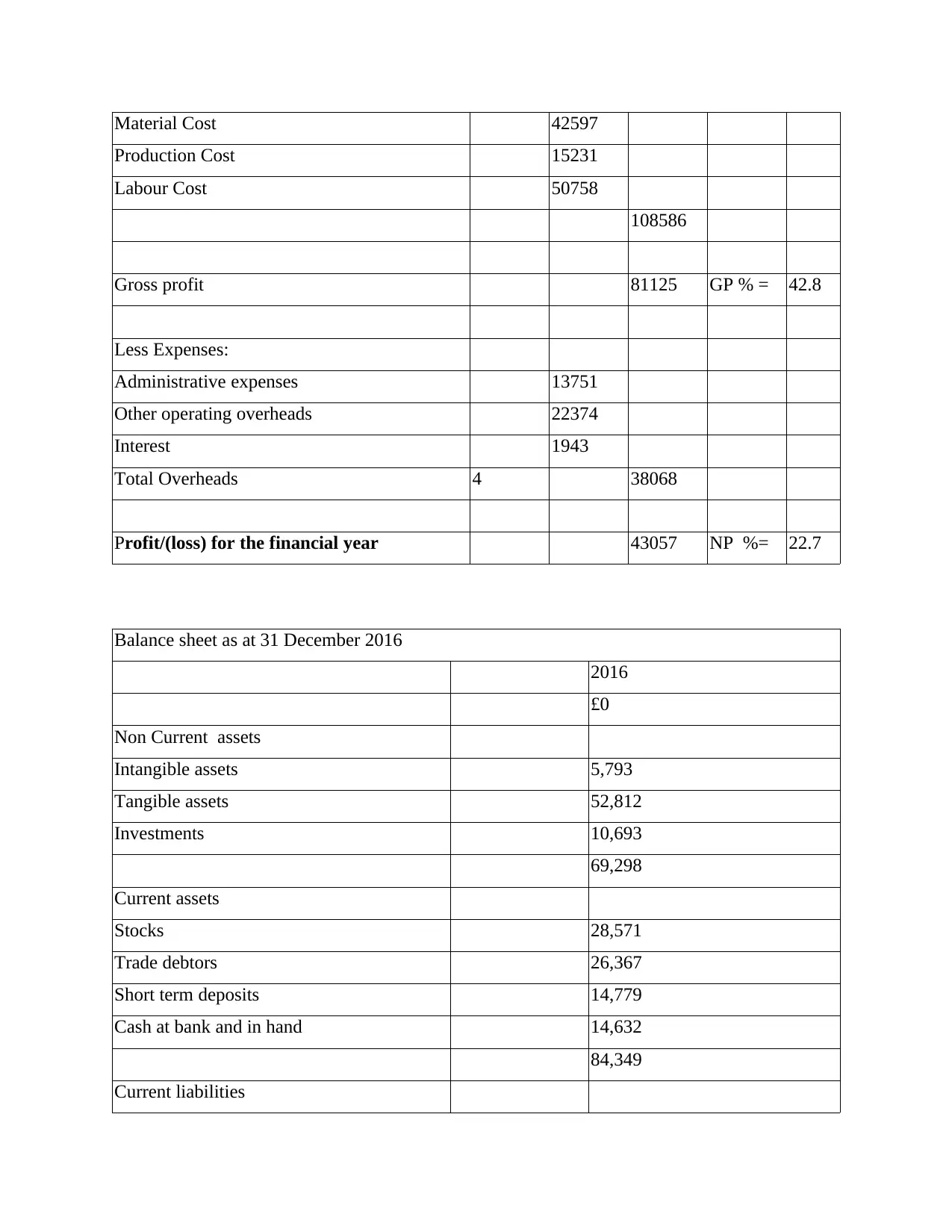
Material Cost 42597
Production Cost 15231
Labour Cost 50758
108586
Gross profit 81125 GP % = 42.8
Less Expenses:
Administrative expenses 13751
Other operating overheads 22374
Interest 1943
Total Overheads 4 38068
Profit/(loss) for the financial year 43057 NP %= 22.7
Balance sheet as at 31 December 2016
2016
£0
Non Current assets
Intangible assets 5,793
Tangible assets 52,812
Investments 10,693
69,298
Current assets
Stocks 28,571
Trade debtors 26,367
Short term deposits 14,779
Cash at bank and in hand 14,632
84,349
Current liabilities
Production Cost 15231
Labour Cost 50758
108586
Gross profit 81125 GP % = 42.8
Less Expenses:
Administrative expenses 13751
Other operating overheads 22374
Interest 1943
Total Overheads 4 38068
Profit/(loss) for the financial year 43057 NP %= 22.7
Balance sheet as at 31 December 2016
2016
£0
Non Current assets
Intangible assets 5,793
Tangible assets 52,812
Investments 10,693
69,298
Current assets
Stocks 28,571
Trade debtors 26,367
Short term deposits 14,779
Cash at bank and in hand 14,632
84,349
Current liabilities
Paraphrase This Document
Need a fresh take? Get an instant paraphrase of this document with our AI Paraphraser
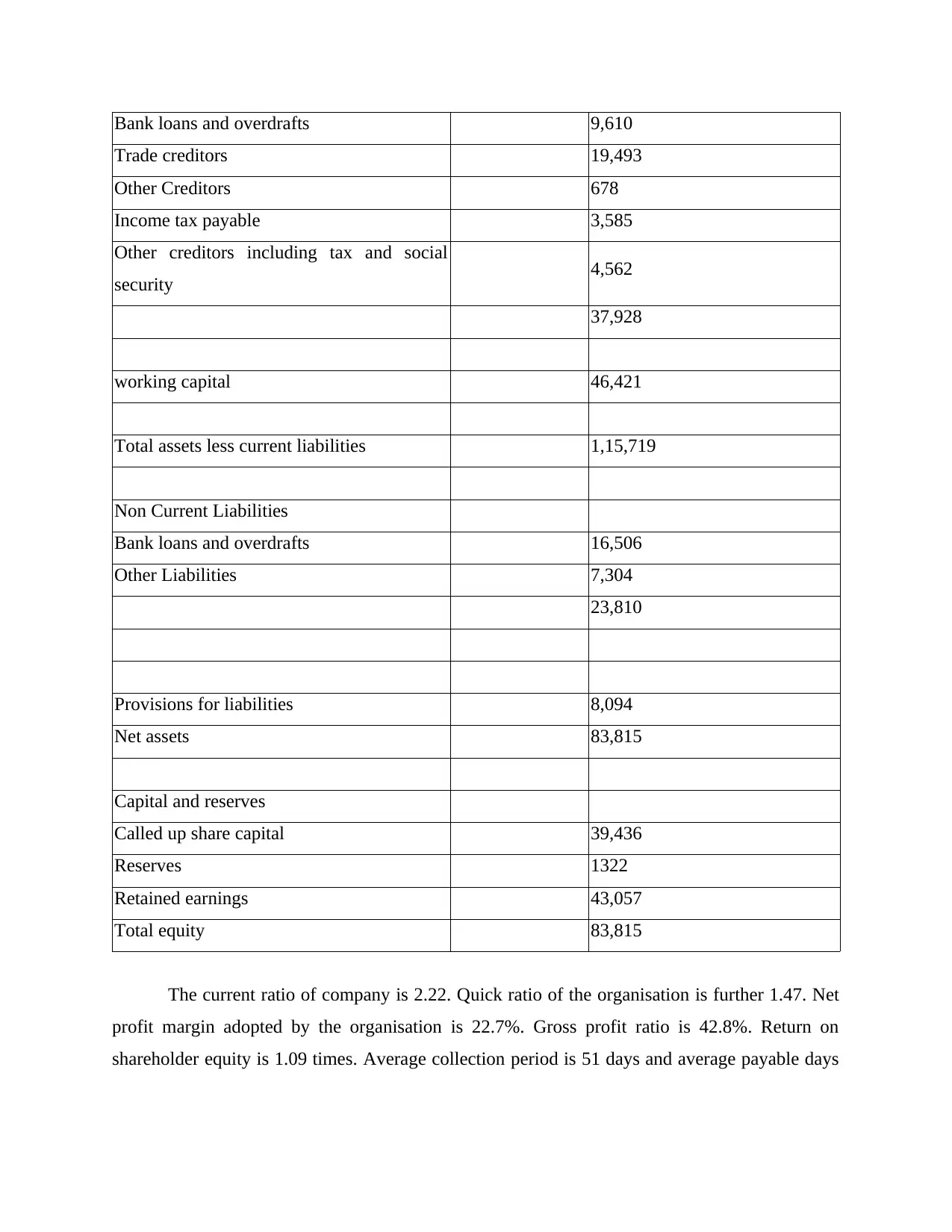
Bank loans and overdrafts 9,610
Trade creditors 19,493
Other Creditors 678
Income tax payable 3,585
Other creditors including tax and social
security 4,562
37,928
working capital 46,421
Total assets less current liabilities 1,15,719
Non Current Liabilities
Bank loans and overdrafts 16,506
Other Liabilities 7,304
23,810
Provisions for liabilities 8,094
Net assets 83,815
Capital and reserves
Called up share capital 39,436
Reserves 1322
Retained earnings 43,057
Total equity 83,815
The current ratio of company is 2.22. Quick ratio of the organisation is further 1.47. Net
profit margin adopted by the organisation is 22.7%. Gross profit ratio is 42.8%. Return on
shareholder equity is 1.09 times. Average collection period is 51 days and average payable days
Trade creditors 19,493
Other Creditors 678
Income tax payable 3,585
Other creditors including tax and social
security 4,562
37,928
working capital 46,421
Total assets less current liabilities 1,15,719
Non Current Liabilities
Bank loans and overdrafts 16,506
Other Liabilities 7,304
23,810
Provisions for liabilities 8,094
Net assets 83,815
Capital and reserves
Called up share capital 39,436
Reserves 1322
Retained earnings 43,057
Total equity 83,815
The current ratio of company is 2.22. Quick ratio of the organisation is further 1.47. Net
profit margin adopted by the organisation is 22.7%. Gross profit ratio is 42.8%. Return on
shareholder equity is 1.09 times. Average collection period is 51 days and average payable days
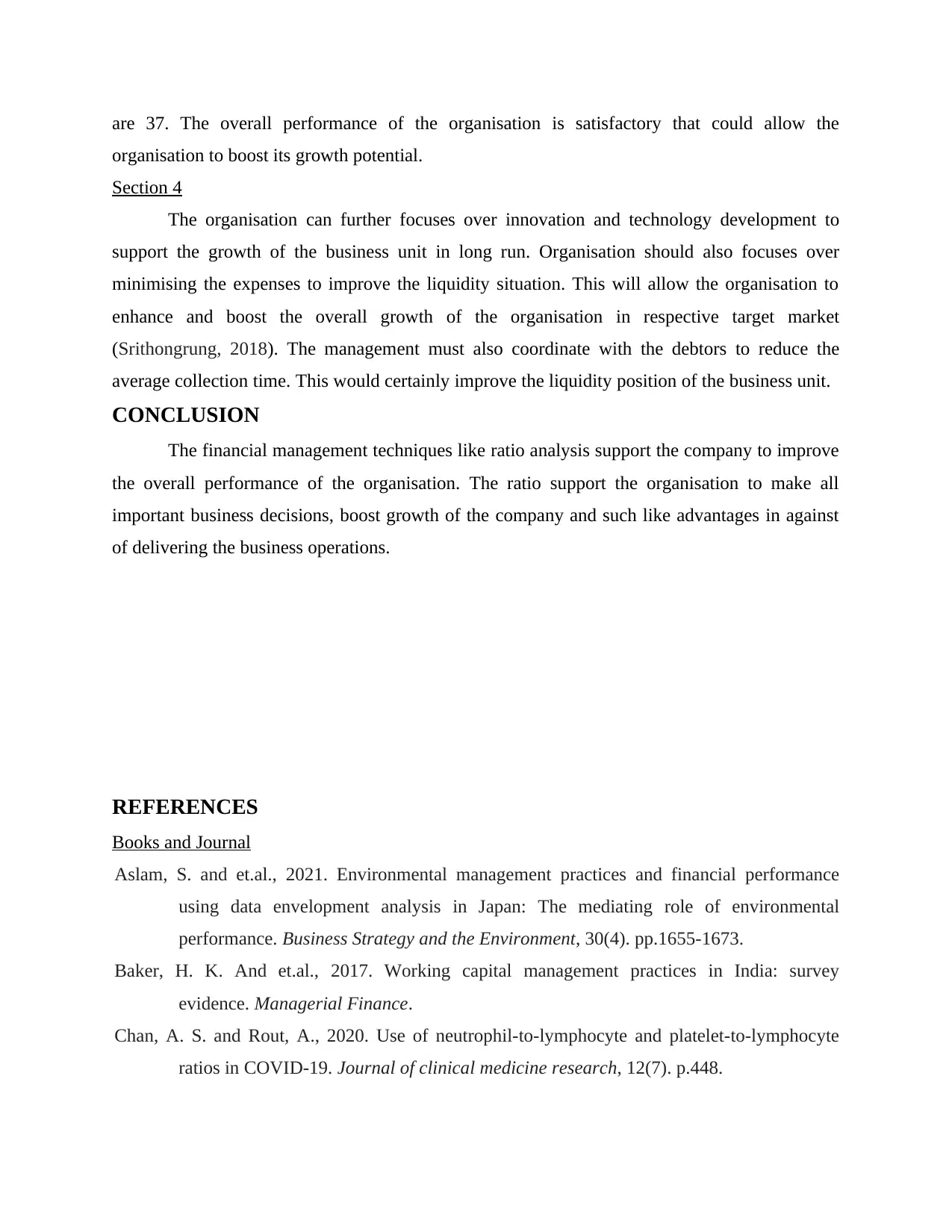
are 37. The overall performance of the organisation is satisfactory that could allow the
organisation to boost its growth potential.
Section 4
The organisation can further focuses over innovation and technology development to
support the growth of the business unit in long run. Organisation should also focuses over
minimising the expenses to improve the liquidity situation. This will allow the organisation to
enhance and boost the overall growth of the organisation in respective target market
(Srithongrung, 2018). The management must also coordinate with the debtors to reduce the
average collection time. This would certainly improve the liquidity position of the business unit.
CONCLUSION
The financial management techniques like ratio analysis support the company to improve
the overall performance of the organisation. The ratio support the organisation to make all
important business decisions, boost growth of the company and such like advantages in against
of delivering the business operations.
REFERENCES
Books and Journal
Aslam, S. and et.al., 2021. Environmental management practices and financial performance
using data envelopment analysis in Japan: The mediating role of environmental
performance. Business Strategy and the Environment, 30(4). pp.1655-1673.
Baker, H. K. And et.al., 2017. Working capital management practices in India: survey
evidence. Managerial Finance.
Chan, A. S. and Rout, A., 2020. Use of neutrophil-to-lymphocyte and platelet-to-lymphocyte
ratios in COVID-19. Journal of clinical medicine research, 12(7). p.448.
organisation to boost its growth potential.
Section 4
The organisation can further focuses over innovation and technology development to
support the growth of the business unit in long run. Organisation should also focuses over
minimising the expenses to improve the liquidity situation. This will allow the organisation to
enhance and boost the overall growth of the organisation in respective target market
(Srithongrung, 2018). The management must also coordinate with the debtors to reduce the
average collection time. This would certainly improve the liquidity position of the business unit.
CONCLUSION
The financial management techniques like ratio analysis support the company to improve
the overall performance of the organisation. The ratio support the organisation to make all
important business decisions, boost growth of the company and such like advantages in against
of delivering the business operations.
REFERENCES
Books and Journal
Aslam, S. and et.al., 2021. Environmental management practices and financial performance
using data envelopment analysis in Japan: The mediating role of environmental
performance. Business Strategy and the Environment, 30(4). pp.1655-1673.
Baker, H. K. And et.al., 2017. Working capital management practices in India: survey
evidence. Managerial Finance.
Chan, A. S. and Rout, A., 2020. Use of neutrophil-to-lymphocyte and platelet-to-lymphocyte
ratios in COVID-19. Journal of clinical medicine research, 12(7). p.448.
⊘ This is a preview!⊘
Do you want full access?
Subscribe today to unlock all pages.

Trusted by 1+ million students worldwide
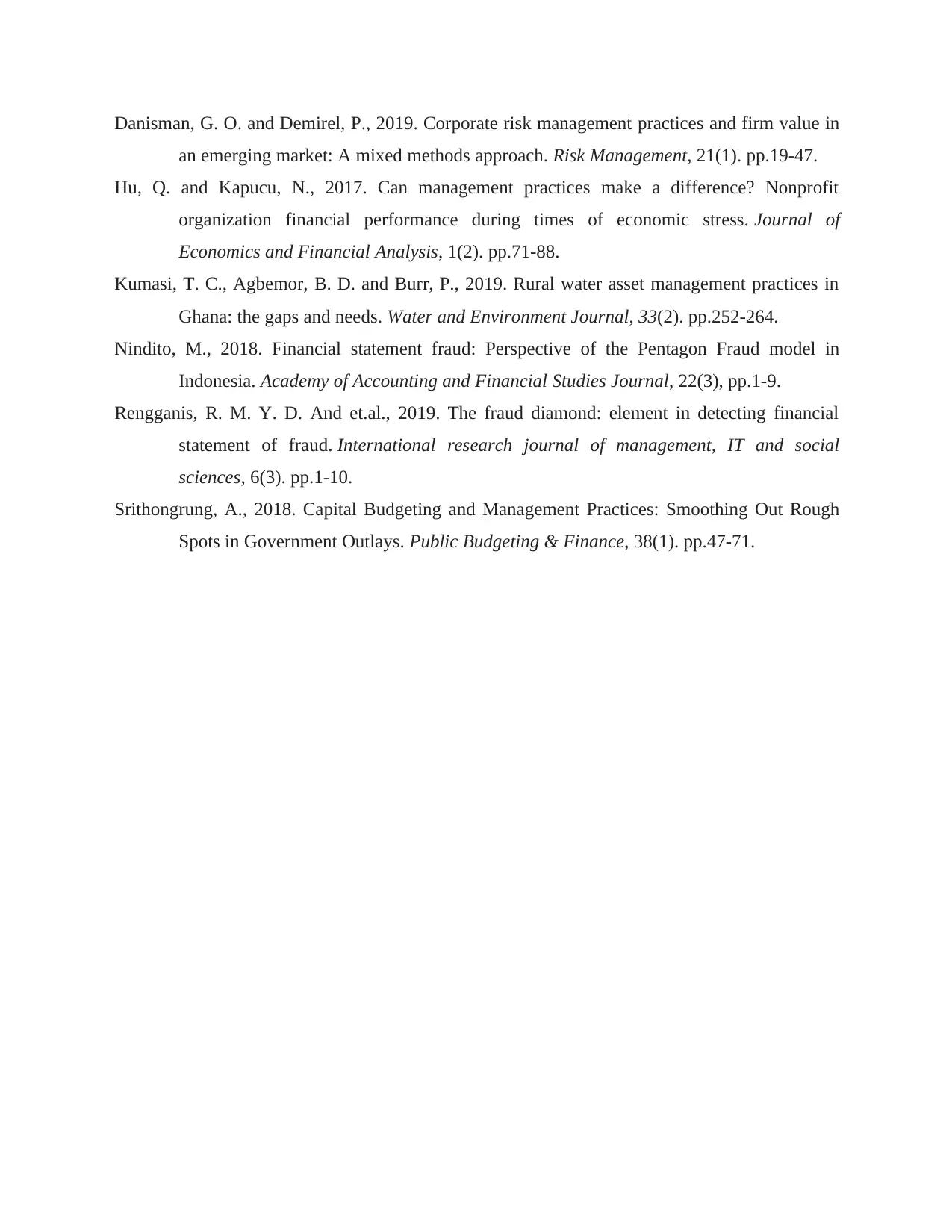
Danisman, G. O. and Demirel, P., 2019. Corporate risk management practices and firm value in
an emerging market: A mixed methods approach. Risk Management, 21(1). pp.19-47.
Hu, Q. and Kapucu, N., 2017. Can management practices make a difference? Nonprofit
organization financial performance during times of economic stress. Journal of
Economics and Financial Analysis, 1(2). pp.71-88.
Kumasi, T. C., Agbemor, B. D. and Burr, P., 2019. Rural water asset management practices in
Ghana: the gaps and needs. Water and Environment Journal, 33(2). pp.252-264.
Nindito, M., 2018. Financial statement fraud: Perspective of the Pentagon Fraud model in
Indonesia. Academy of Accounting and Financial Studies Journal, 22(3), pp.1-9.
Rengganis, R. M. Y. D. And et.al., 2019. The fraud diamond: element in detecting financial
statement of fraud. International research journal of management, IT and social
sciences, 6(3). pp.1-10.
Srithongrung, A., 2018. Capital Budgeting and Management Practices: Smoothing Out Rough
Spots in Government Outlays. Public Budgeting & Finance, 38(1). pp.47-71.
an emerging market: A mixed methods approach. Risk Management, 21(1). pp.19-47.
Hu, Q. and Kapucu, N., 2017. Can management practices make a difference? Nonprofit
organization financial performance during times of economic stress. Journal of
Economics and Financial Analysis, 1(2). pp.71-88.
Kumasi, T. C., Agbemor, B. D. and Burr, P., 2019. Rural water asset management practices in
Ghana: the gaps and needs. Water and Environment Journal, 33(2). pp.252-264.
Nindito, M., 2018. Financial statement fraud: Perspective of the Pentagon Fraud model in
Indonesia. Academy of Accounting and Financial Studies Journal, 22(3), pp.1-9.
Rengganis, R. M. Y. D. And et.al., 2019. The fraud diamond: element in detecting financial
statement of fraud. International research journal of management, IT and social
sciences, 6(3). pp.1-10.
Srithongrung, A., 2018. Capital Budgeting and Management Practices: Smoothing Out Rough
Spots in Government Outlays. Public Budgeting & Finance, 38(1). pp.47-71.
1 out of 10
Related Documents
Your All-in-One AI-Powered Toolkit for Academic Success.
+13062052269
info@desklib.com
Available 24*7 on WhatsApp / Email
![[object Object]](/_next/static/media/star-bottom.7253800d.svg)
Unlock your academic potential
Copyright © 2020–2025 A2Z Services. All Rights Reserved. Developed and managed by ZUCOL.





